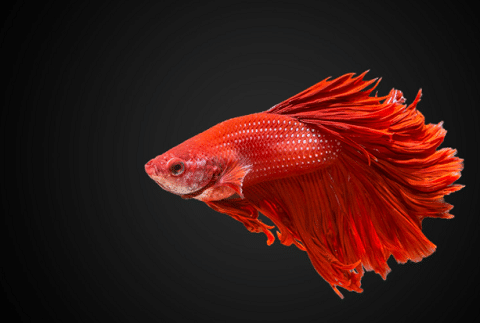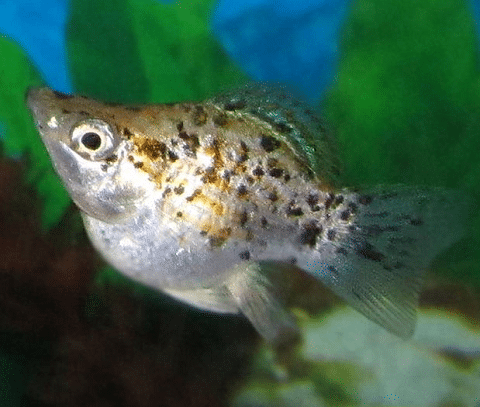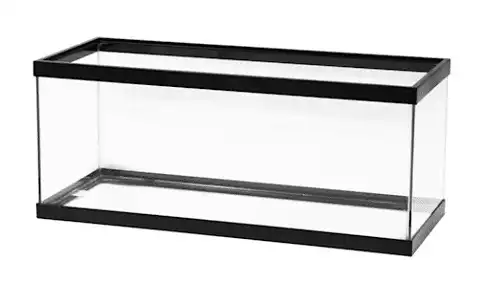Thank you for visiting! By the way… any links on this page that lead to products on Amazon and other stores/partners are affiliate links Aquarium Store Depot earns a commission if you make a purchase.
Can Mollies Live With Bettas? Well, it depends.
This is one of the top questions discussed in the aquarium hobby and there is no straightforward answer. Some hobbyists have had success keeping bettas with other tropical species, like molly fish, while other aquarists have failed miserably. If you find that your betta is accepting of other fish, then you might consider a molly fish pairing.
Keep reading to find out everything you need to know about mollies and bettas, and keep these two species together!
Key Takeaways
- Molly fish and betta fish can live in the same aquarium with some special considerations.
- Mollies can be kept with female or male bettas depending on their temperament.
- Tank size, tank setup, personality, and acclimation methods all need to be considered to make this pairing successful.
- Even then, molly fish might not be able to live with a betta.
Intro to Molly Fish

Molly fish may be beginner tropical fish but they’re highly adaptable and can be kept in freshwater, saltwater, or brackish water conditions. They’re active, colorful fish that are very tolerant of imperfect or volatile water parameters. That being said, their preferred tank conditions align with those of bettas.
Molly fish (Poecilia spp.) are native to North America, with a natural range from the southern United States to Mexico, though they’ve been introduced worldwide. These fish are commonly found in brackish conditions near the coastline and prefer heavily-planted areas with some water flow.
Nowadays, it is rare to find wild-caught molly fish available for purchase. In fact, you might not even recognize a wild molly as they have large fins and naturally bright colors. This is very different from the selectively bred colors and varieties available today. Some of these include:
- Balloon mollies
- Lyretail mollies
- Sailfin mollies
These fish grow to be about 3-5 inches at mature size, and feature mostly black, white, yellow, and orange solid color and patterning.
Behavior
Molly fish are active fish that like to be kept in small groups of at least 3 or more. They are not tight schoolers and will loosely move around the top portions of the tank in a shoal.
While not aggressive, these fish are bold. They are always present in the aquarium and might nip at long fins. During feeding time, they can be overly ambitious and might outcompete other small and slower species.
Tank Requirements
Mollies are one of the hardest fish available period. These fish can adapt to freshwater, brackish, and saltwater conditions and withstand imperfect water parameters. That being said, they should never be subjected to improper care, like being used to cycle an aquarium.
These are relatively large and active fish, which means they need a decent-sized tank. The minimum tank size recommended for a group of molly fish is 15 gallons with a 20 gallon tank leaving more room for open swimming. As we’ll see, tank size will play an important role in making these fish suitable tank mates for bettas.
A classic 20 gallon aquarium in its 30 inch long variant. A very popular aquarium.
Like in their natural habitat, mollies love dense vegetation with plenty of live plants and driftwood that they can hide in and interact with. These do not need to be high-tech plants, but quantity is important.
How Can Mollies Live With Bettas?
Now that we know a little bit about mollies, we can start to understand how they can be compatible tank mates with bettas.

In contrast to the peaceful yet active molly, betta fish are slow-moving and aggressive. Betta fish are very territorial and will nip at and possibly kill any fish that enters their territory. This is especially true for more colorful male betta fish, but female bettas can be just as aggressive. While both male and female betta fish are known to attack, mollies can also be fin nippers which can damage delicate fins.
Another problem is that molly fish and betta fish like to occupy the same areas of the tank. Both freshwater fish prefer the upper portions of the water column, where their personalities will clash the most. This is especially important to consider during feeding times when mollies are eager and determined, while betta fish are much more docile feeders. This could lead to a betta getting outcompeted and injured by a more ambitious group of mollies.
It might seem like these two fish are completely incompatible, but believe it or not, many hobbyists have had this pairing work. First, we need to consider the variety of molly fish best suited for a betta tank setup.
Balloon Mollies

Balloon mollies are easily identifiable by their inflated bellies. They share all other molly characteristics but are more unique in stature. Unfortunately, this uniqueness has some downsides.
There is some discussion in the aquarium hobby about how selective breeding has affected the livelihood of these fish. Some hobbyists find that balloon mollies deform over time and are more susceptible to aquarium diseases, leading to a shorter lifespan.
When trying to make a difficult tank mate pairing work, you want the healthiest fish possible that can guarantee long-term success. Sadly, the balloon molly is better off in their own separate tank.
Lyretail Mollies

Lyretail mollies1 are more similar to their wild ancestors but are ultimately incompatible with betta fish. These are beautiful fish with long flowing fins, especially seen in the male mollies. However, there are a few problems to consider when trying to keep these fish in betta tanks.
Lyretail mollies have long tails. Betta fish have long tails. Mollies are fin nippers. Betta fish are fin nippers. While mollies usually nip to establish a pecking order, betta fish do this to defend their territory. It is not unheard of for mollies to start nipping the fins of other fish though, and this is where the problem is.
Believe it or not, a docile betta fish can become susceptible to molly bullying. This can lead to fin rot and unnecessary stress for the betta. In return, an overly aggressive betta could destroy a lyretail’s fins and even kill the fish. In worst-case scenarios, the betta fish might mistake the lyretail molly for another betta.
Because of the possible bullying and aggression that can arise between lyretail molly fish and bettas, this variety does make a good betta tank mate.
Sailfin Mollies

For the same reasons as lyretails, sailfin mollies are also incompatible betta tank mates. Even more similar to wild mollies, sailfin mollies have extended dorsal and tail fins that are easily nipped at. These fish also tend to have more iridescent colors that could cause a betta fish to misidentify them.
Both of these factors could lead to bullying and aggression between the two species, making them best kept separately.
Regular Mollies
It might seem boring or plain, but regular mollies (Poecilia sphenops) are the best variety available for a betta fish tank pairing. These are sometimes called shortfin mollies, with solid black being the most predominant color option available.
These fish can look a lot like platies, but their bodies are slightly more streamlined and pointed. In other words, their appearance is unremarkable–which is exactly the kind of fish you want to pair with a betta!
Regular mollies are often compatible with betta fish as the temptation of a betta fin nipping or attacking because of color is eliminated. However, there is still the chance that a molly will fin nip at a betta, so there are a few more steps that need to be taken to increase the chances of success.
How To Pair
With possible aggression in mind, how can you increase the chances of a successful pairing between regular mollies and a betta fish? There are many ways to help both your molly and betta feel at home together in the same tank, from the first steps of acclimation to being able to deal with problems when they arise. Still, there are some times when the pairing is simply incompatible.
Here’s how to successfully keep shortfin mollies with a betta fish!
Male vs Female Bettas
Contrary to popular belief, female betta fish are much more similar to their male counterparts than people give them credit for. These are Siamese fighting fish that have earned their name by fighting each other and other fish to death.
While males show their aggression more colorfully, females can be just as aggressive towards other fish. If anything, male betta fish might actually be slowed down during attacks compared to females due to their excessive finnage, though both are capable of delivering deadly blows.
So which is better for a betta and molly fish tank?
In general, female bettas are still considered to be safer to keep with mollies than males, but careful attention is still needed. It should be noted that many hobbyists have had equal success keeping male betta fish with mollies as well.
Male vs Female Molly Fish
Another factor to consider is the male-to-female ratio of molly fish. Luckily, male and female mollies are pretty easy to tell apart. In most cases, you should only keep female mollies in a betta fish pairing.
The most successful pairing of these two fish comes from calm and controlled environments. While not aggressive, male mollies can definitely become determined and overly dominant during breeding periods. Having both male and female mollies in the aquarium would only lead to more aggression that could feed otherwise docile fish. In addition, male mollies are typically more ornate than their female counterparts, possibly confusing betta fish.
Fry
Another factor to consider is that having both male and female molles could lead to excess breeding. These fish are prolific livebearers and will continue to reproduce indefinitely. Both female and male bettas will eagerly eat any fry they come across in the aquarium.
Tank Size
Both bettas and mollies are small fish, but adding this aggressive and active pairing together increases the minimum tank size needed. For a small group of mollies, a 20 gallon aquarium should comfortably hold these two species together. However, a 25 or 30 gallon aquarium would allow much more room for separate territories and spaces to be established.
Remember that even though the tank might look sparse with such few fish, the tank is fully stocked and other fish cannot be added.
Tank Setup
Another way to increase chances of success is by setting up the tank so that each fish can comfortably stay in its own space. Both bettas and mollies love live plants, and filling the aquarium with vegetation will help improve water quality while providing plenty of hiding places. If enough plants and decorations are added, it’s possible that these fish won’t even encounter each other often in the tank, which is the ideal scenario.
Feeding
Betta fish are greedy, but they’re not ambitious eaters. Molly fish are active and ambitious, so special attention needs to be given during feeding times.
Betta fish love eating from the surface of the water, right where mollies spend most of their time. While a large enough tank should help disperse the two fish, it might be necessary to target feed.

First, find out which food your betta fish prefers to eat: floating or sinking. Then, feed your mollies the opposite. In general, betta fish are more picky about eating than mollies, so you should always try to accommodate them first.
To further help decrease aggression during feeding times, feed small amounts several times throughout the day. This should help make food less eventful, lowering the overall excitement in the tank. Adding additional enrichment through live food can also help both fish from getting bored while providing exercise.
Individual Personality
Last but not least, you need to understand the personalities of your fish. Betta fish have very present personalities that can range from timid and shy to attacking their own reflections. Molly fish are much more predictable, but you might get an especially aggressive one within the group.
As we’ll see, it’s best to introduce the molly fish first into the aquarium. Watch how the fish behave among themselves. If there’s a lot of fin nipping, then you might need to add more individuals or remove the problematic ones. Adding more hiding spots can also help make fish more comfortable in their environment.
Then, observe your betta fish. Go to your pet store and see how they act. Ask to see them be fed. Though this isn’t a true indicator of how they’ll acclimate to your own tank, you can usually tell if they’re more feisty or laidback. During acclimation, you may also get the first sight of how your betta fish reacts to other tank mates.
Acclimation
Once you’ve decided on a female or male betta fish and a group of female mollies, it’s time to think about how you’ll safely add them to the aquarium.
For a dangerous pairing like this, don’t introduce fish directly in the same tank at the same time. Instead, use a clear breeding box to introduce the fish to each other, examining their behaviors and determining if they’re compatible. For the best chances of success, the molly fish should be added before the betta so that they are familiar with the aquarium and establish their own preferred space.
If the fish seem uninterested in each other while separated by the breeding box and there are no signs of aggression, like gill flaring, then the fish may be added.
Recovery
Successful acclimation is the first step. At any given time and for no apparent reason, a male or female betta fish may start to become aggressive towards their tank mates. In return, a molly fish might start to nip at a more submissive betta fish.
Because of this, the tank should be checked every day. Watch how the tank mates interact with each other and intervene at the first signs of behavior change. Be ready to provide a temporary and permanent home for either fish if needed.
Alternative Tank Mates
If you have the room, molly fish are not the only tank mates that could be kept in your betta aquarium. Again, you will need to consider all the factors on this list, especially the personality of your female or male betta fish. With a large enough tank, appropriate tank setup, and careful observation, some possible fish you could add to a betta aquarium are:
FAQs
Can I keep a betta with mollies?
Betta fish can sometimes be kept with mollies. Some conditions, like tank size, tank setup, and compatibility need to be met before successfully keeping these fish together. Even then, this pairing might not be successful.
What fish can mollies not live with?
Molly fish can be kept with many fish available in the aquarium hobby, including freshwater, brackish, and saltwater species. They are successfully kept with many fish that are both bigger and smaller than them, ranging in aggression from completely peaceful to fully aggressive. However, mollies are active fish that can overwhelm small and docile fish. They are also a good-sized snack for fish with especially large mouths.
Will betta fish kill guppies?
It’s always a possibility that a betta fish will kill any fish it’s kept with. Many steps need to be taken to pair female and male bettas with any other fish, accommodating tank size and tank setup. For many hobbyists, pairing bettas with guppies is challenging.
What fish can live with molly fish?
Most tropical community fish can be kept with mollies, but some hobbyists have had success keeping them with betta fish as well. These fish can live in freshwater, brackish, and saltwater conditions, so there are many tank mate options!
Conclusion
Bettas and mollies are two beginner fish that hobbyists will likely have at some point throughout their aquarium-keeping careers. But can they have them at the same time, together? While mollies and bettas can be successfully kept together in the same aquarium with careful consideration, this pairing can be difficult. Betta fish are slow and aggressive while mollies are active and peaceful. With the right setup though, these two fish can live together.
- About the Author
- Latest Posts
I’m thrilled that you found Aquarium Store Depot! Here you’ll find information on fish, aquariums, and all things aquatics related. I’m a hobbyist (being doing this since I was 11) and here to help other hobbyists thrive with their aquariums! I adhere to a high quality Editorial Process and Review products with real life field usage and practical analysis.






